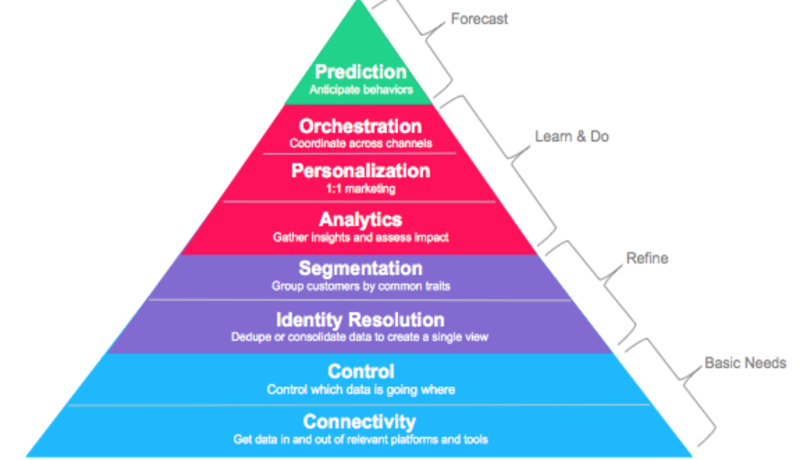4 Fundamentals for data-driven marketing
Maslow's hierarchy states that before catering you wants, you must ensure your needs are covered. Learn what your marketing needs are before embarking on your quest for data-driven marketing.

First, master the fundamentals.
Digital marketers are notorious for loving quick hacks, silver bullets, and shiny objects. One might argue it’s been a useful evolutionary trait, as it encourages experimentation with all the latest platforms and tools.
But, to prepare themselves for a marketing environments that’s increasingly data-driven, marketers need to slow down and methodically build a proper foundation, or they’ll never be able to move as fast and as forcefully as they’d like. Here’s a framework for thinking about what that looks like…
Your data-driven marketing needs
First and foremost, a good foundation distinguishes between data infrastructure and the application of data. Analytics, personalized engagement and orchestrated, multichannel campaigns are all different applications of data. Data infrastructure is what underpins them all.
Data-driven marketing infrastructure can be grouped into four key skills:
- Connectivity: being able to collect the data you want from all the places you want (at the speed and the in the format you need it);
- Control: being able to manage data usage, privacy, security, and quality on a continual basis;
- Identity resolution: being able to identify a given prospect or customer with accuracy (across devices, and stages of the customer journey); and,
- Segmentation: being able to group customers together into segments, which make it practical to send messages to them at scale (which is the function of marketing as opposed to sales).
While identity resolution and segmentation are critically important, the point I’d like to make here is that connectivity and control are the most foundational of them all. Without good, clean, secure data, everything else is academic.

Hierarchy of data-driven marketing
Your data fundamentals checklist
To check if you’ve mastered the Basic Needs of Connecting and Control, ask yourself these five question:
- Are you collecting all the data you need? Your connectivity layer must be fit for powering your entire stack, not just a component of it. That means you must collect the full spectrum of app data from mobile and connected devices, as well as data from more traditional sources like web and CRM. This is the only way to develop those core muscles.
- Can your data move with speed and agility? Your connectivity layer must be partner and channel agnostic, and able to quickly and efficiently move data exactly where you need it to go and when you need it. Forward, backward, side to side. The API endpoints should be well documented, too, because data-driven marketing is a team sport, after all.
- Are your data connections flexible and extensible? There is a lot of intelligence that goes into a proper connectivity layer to maintain high quality standards and “translate” data to support each of the various endpoints you may require. In some cases, data may need to be mapped to meet a vendor’s taxonomies. In other cases, a vendor may impose throttling limits. Your approach must be flexible enough to accommodate these different scenarios, and not be just a dumb pipe.
- Is your data resilient to platform change? Vendor APIs change all the time. If your connectivity layer is robust, these changes won’t throw you off your game. If it isn’t, you will be constantly subject to “whack a mole” integration efforts and stress. This is particularly true of APIs that rely on mobile app SDKs since they require an app store update pushed to end users’ devices. Without a proper connectivity layer, you will be stuck spending all of your time integrating, not innovating.
- Is your data safe and under control? Finally, your connectivity layers needs to be secure and reliable from end to end. Data leakage is real and it can cost you the whole game. Ensure you have live monitoring capabilities to troubleshoot bugs, error alerting so problems don’t stay hidden, and the ability to “replay” backup data at any point.
Absent mastery over the Basic Needs, marketers are like a football team that hasn’t practiced running, blocking, and tackling. They may get lucky and score a few quick points, but it’s not sustainable or repeatable.
In fact, it will only become more of an issue as marketing department come to depend increasingly on machines that lack intuition, and only “learn” through access to large data repositories which need to be always-on, well-structured and controlled (sloppy data lakes won’t cut it). All the more reason why companies need to get their data foundations in order, stat.
The good news is, once you’ve mastered these fundamentals, it’s easy to start layering-in trick plays that can be total game-changers.



